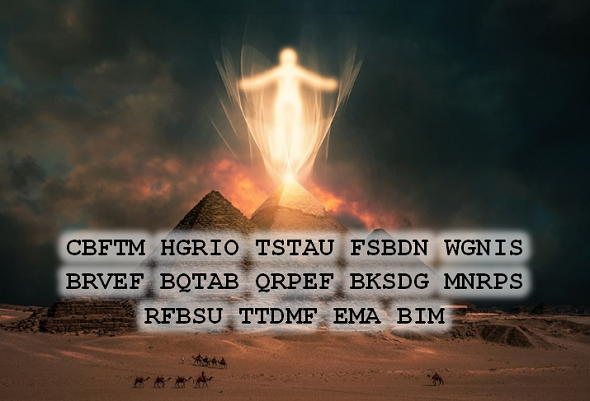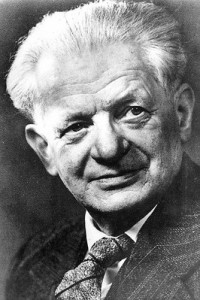In 1948, an anonymous codebreaker deciphered an encrypted message by British parapsychologist Robert Thouless. The solution is known. Can a reader find out how the successful attack worked?
Frequent readers of this blog certainly have heard of British parapsychologist Robert Thouless.
In 1948, Thouless started an interesting experiment. He took a text, encrypted it and published the result (i.e., the ciphertext), while he kept the cleartext and the key secret. His plan was to communicate the key from the beyond after his death. If somebody received the correct key from the realm of the dead, which would lead to the cryptogram being solved, this would prove that there is a life after death and that the dead can communicate with the living.
Thouless’ first try failed: the message he published was broken by an anonymous person (not in a supernatural way, but with codebreaking techniques). More details about Thouless’ experiment are available here (English blog post) and here (German Telepolis article). Thouless’ third attempt (also known as message C) is still unsolved.
Apart from the solution of Thouless’ third cipher message, there’s another question about this experiment that is still unanswered: how did the anonymous codebreaker decipher Thouless’ first message?
Thouless’ first message
Let’s look at the details. Here’s the cleartext of Thouless’ first message (it’s a Shakespeare quote):
BALM OF HURT MINDS GREAT NATURE’S SECOND COURSE CHIEF NOURISHER IN LIFE’S FEAST
The encryption method Thouless used is the Playfair cipher. The Playfair cipher substitutes letter pairs. So, we need to write the cleartext as a sequence of letter pairs:
BA LM OF HU RT MI ND SG RE AT NA TU RE SS EC ON DC OU RS EC HI EF NO UR IS HE RI NL IF ES FE AS T
The Playfair cipher requires that no letter pair consist of two equal letters. Therefore, Thouless added an X between the two Ss:
BA LM OF HU RT MI ND SG RE AT NA TU RE SX SE CO ND CO UR SE CH IE FN OU RI SH ER IN LI FE SF EA ST
If the number of letters in this cleartext were odd, another X would have to be added at the last position, but this is not necessary here. Next, Thouless chose a keyword: SURPRISE. Now, he set up a 5×5 matrix, which started with the keyword (repeating letters are omitted), followed by the remaining alphabet (I and J are considered equal in order to get an alphabet of 25 letters):
S U R P I E A B C D F G H K L M N O Q T V W X Y Z
Now, Thouless replaced the cleartext letter pairs (BA, LM, OF, HU, …) according to the three Playfair rules. Here are the rules in a diagram:
Here are the Playfair rules as a text (I refer to the letter pair to be replaced as XY):
- If X and Y are not in the same column and not in the same row (this is the most frequent case), form a rectangle and replace the two letters by the other two corner letters (the upper cleartext letter is replaced by the other upper letter in the rectangle, the lower cleartext letter by the lower one). For instance, LM becomes FT.
- If the two letters stand in the same row, each one is replaced by its right neighbor. Here, BA becomes CB.
- If the two letters stand in the same column, each one is replaced by its lower neighbor. In our example, AN becomes GW.
When applying the Playfair rules on the 5×5 matrix above, Thouless’ Shakespeare quote encrypts to:
CB FT MH GR IO TS TA UF SB DN WG NI SB RV EF BQ TA BQ RP EF BK SD GM NR PS RF BS UT TD MF EM AB IM
Thouless published this cryptogram in the following way (the positions of the spaces is changed):
CBFTM HGRIO TSTAU FSBDN WGNIS BRVEF BQTAB QRPEF BKSDG MNRPS RFBSU TTDMF EMA BIM
How was it broken?
As mentioned, Thouless first message was broken within a few weeks. The identity of the person who solved it is not known, neither is the codebreaking method he or she used. At least, it is clear that this person didn’t use the following two techniques:
- Dictionary attack: Today, it is possible to break a Playfair cipher by guessing the keyword. The word SURPRISE is contained in virtually every English dictionary, so a computer that tests one keyword candidate after the other will sooner or later find it. However, in 1948, the anonymous codebreaker certainly had no computer available.
- Hill climbing: Hill climbing is the current super-algorithm in historical codebreaking. However, in 1948, neither the algorithm nor the computer technology necessary to implement it existed.
There are several books that explain how a Playfair can be solved without computer support, for instance Helen Fouché Gaines’ Cryptanalysis and André Langie’s Cryptography. The concept is to guess a few words in the cleartext and to derive the 5×5 matrix based on the peculiarities of the Playfair cipher (for instance, if AB->XY then BA->YX).
However, breaking a Playfair cryptogram manually is pretty difficult, especially if the ciphertext is as short as here (the Thouless message consists of 66 letters). The examples described in the books mentioned above all refer to much longer messages. In addition, these books assume that a few words of the cleartext are known. Nevertheless, none of these books describes the complete Playfair codebreaking procedure – instead, most of the trial-and-error reckoning necessary is simply omitted.
All in all, this means that the anonymous solver of the first Thouless message did a great job. I am asking myself:
- Which words did the anonymous codebreaker guess?
- How did he or she reconstruct the matrix based on this knowledge?
Or did the anonymous solver find a completely different way to break Thouless’ Playfair message? Any comments about this mystery are welcome.
Follow @KlausSchmeh
Further reading: The Top 50 unsolved encrypted messages: 43. The Rayburn murder cryptogram
Linkedin: https://www.linkedin.com/groups/13501820
Facebook: https://www.facebook.com/groups/763282653806483/





Kommentare (10)